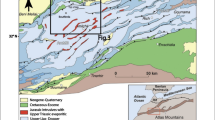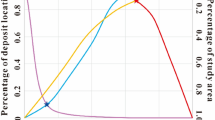Abstract
Identifying weak geochemical anomalies from background is vital in the exploration of complex metallogenic systems. The window-based local singularity analysis (LSA) method is widely used to quantitatively characterize the local singularity structural properties of nonlinear geological processes. In this study, a batch method for local singularity mapping based on quadtree is proposed to improve the spatial retrieval efficiency in batch process with various parameters. Compared to conventional spatial retrieval methods, the quadtree-based local singularity analysis method can significantly enhance retrieval efficiency and reduce calculation time, especially in the batch process. In the case study, the quadtree-based LSA is further applied to characterize Au mineralization associated with geochemical anomalies at Baishilazi, in the province of Heilongjiang, China. A total of seven factors related to window-based LSA including window shape, orientation, aspect ratio, window initial size, step size, maximum window size and average concentration calculation method are considered, and the optimal parameter combination is determined based on receiver operating characteristic curves (ROC) and area under the ROC curves (AUC). The exploration targets are further delineated using the t test. The results show that the quadtree-based LSA is an efficient tool for optimal parameter determination in the batch process.








Similar content being viewed by others
Data availability
The datasets generated and/or analyzed during the current study are available from the author upon reasonable request.
Code availability
The code applied and/or analyzed during the current study is available from the author upon reasonable request.
References
Agterberg FP (2012) Multifractals and geostatistics. J Geochem Explor 122:113–122
Afzal P, Alghalandis YF, Khakzad A, Moarefvand P, Omran NR (2011) Delineation of mineralization zones in porphyry Cu deposits by fractal concentration–volume modeling. J Geochem Explor 108(3):220–232
Asadi HH, Kianpouryan S, Lu YJ, McCuaig TC (2014) Exploratory data analysis and C–A fractal model applied in mapping multi-element soil anomalies for drilling: A case study from the Sari Gunay epithermal gold deposit, NW Iran. J Geochem Explor 145:233–241
Bai J, Porwal A, Hart C, Ford A, Yu L (2010) Mapping geochemical singularity using multifractal analysis: Application to anomaly definition on stream sediments data from Funin Sheet, Yunnan, China. J Geochem Explor 104(1-2):1–11
Bentley JL (1975) Multidimensional binary search trees used for associative searching. Commun ACM 18(9):509–517
Chen G, Cheng Q (2018) Fractal-based wavelet filter for separating geophysical or geochemical anomalies from background. Math Geosci 50(3):249–272
Chen Z, Cheng Q, Chen J, Xie S (2007) A novel iterative approach for mapping local singularities from geochemical data. Nonlinear Process Geophys 14(3):317–324
Cheng Q (1999) Spatial and scaling modelling for geochemical anomaly separation. J Geochem Explor 65(3):175–194
Cheng Q (2007) Mapping singularities with stream sediment geochemical data for prediction of undiscovered mineral deposits in Gejiu, Yunnan Province, China. Ore Geol Rev 32(1-2):314–324
Cheng Q (2012) Singularity theory and methods for mapping geochemical anomalies caused by buried sources and for predicting undiscovered mineral deposits in covered areas. J Geochem Explor 122:55–70
Cheng Q, Agterberg FP, Ballantyne SB (1994) The separation of geochemical anomalies from background by fractal methods. J Geochem Explor 51(2):109–130
Cheng Q, Xu Y, Grunsky E (2000) Integrated spatial and spectrum method for geochemical anomaly separation. Nat Resour Res 9(1):43–52
Carranza EJM (2009). Geochemical anomaly and mineral prospectivity mapping in GIS. Handbook of Exploration and Environmental Geochemistry, Vol. 11, M. Hale (Series Editor).
Finkel RA, Bentley JL (1974) Quad trees a data structure for retrieval on composite keys. Acta Informatica 4(1):1–9
Ghasemzadeh S, Maghsoudi A, Yousefi M, Mihalasky MJ (2019) Stream sediment geochemical data analysis for district-scale mineral exploration targeting: Measuring the performance of the spatial U-statistic and CA fractal modeling. Ore Geol Rev 113:103115
Ghezelbash R, Maghsoudi A, Carranza EJM (2019) Mapping of single-and multi-element geochemical indicators based on catchment basin analysis: Application of fractal method and unsupervised clustering models. J Geochem Explor 199:90–104
Guttman, A. (1984, June). R-trees: A dynamic index structure for spatial searching. In Proceedings of the 1984 ACM SIGMOD international conference on Management of data (pp. 47-57).
Jolliffe IT, Cadima J (2016) Principal component analysis: a review and recent developments. Philos Trans R Soc A Math Phys Eng Sci 374(2065):20150202
Li C, Ma T, Shi J (2003) Application of a fractal method relating concentrations and distances for separation of geochemical anomalies from background. J Geochem Explor 77(2-3):167–175
Li Q, Cheng Q (2004) Multifractal singular-value-decomposition and reconstruction of geochemical and geophysical data. J China Univ Geosci 29(1):109–118
Malamud BD, Turcotte DL, Guzzetti F, Reichenbach P (2004) Landslide inventories and their statistical properties. Earth Surf Process Landf 29(6):687–711
Mandelbrot BB (1983) The fractal geometry of nature. Freeman, San Francisco (468 pp.).
Sadeghi B (2020) Concentration-concentration fractal modelling: a novel insight for correlation between variables in response to changes in the underlying controlling geological-geochemical processes. Ore Geol Rev 103875
Sadeghi B, Moarefvand P, Afzal P, Yasrebi AB, Saein LD (2012) Application of fractal models to outline mineralized zones in the Zaghia iron ore deposit, Central Iran. J Geochem Explor 122:9–19
Sornette, D. (2006). Critical phenomena in natural sciences: chaos, fractals, selforganization and disorder: concepts and tools. Springer Science & Business Media.
Turcotte DL (1997) Fractals and chaos in geology and geophysics. second edition.Cambridge University Press (398 pp.).
Veneziano D, Yoon S (2013) Rainfall extremes, excesses, and intensity‐duration‐frequency curves: A unified asymptotic framework and new nonasymptotic results based on multifractal measures. Water Resour Res 49(7):4320–4334
Wang W, Cheng Q, Zhang S, Zhao J (2018) Anisotropic singularity: A novel way to characterize controlling effects of geological processes on mineralization. J Geochem Explor 189:32–41
Wang W, Zhao J, Cheng Q (2013) Fault trace-oriented singularity mapping technique to characterize anisotropic geochemical signatures in Gejiu mineral district, China. J Geochem Explor 134:27–37
Wold S, Esbensen K, Geladi P (1987) Principal component analysis. Chemom Intell Lab Syst 2(1-3):37–52
Xiao F, Chen J, Hou W, Wang Z, Zhou Y, Erten O (2018) A spatially weighted singularity mapping method applied to identify epithermal Ag and Pb-Zn polymetallic mineralization associated geochemical anomaly in Northwest Zhejiang, China. J Geochem Explor 189:122–137
Xiao F, Chen Z, Chen J, Zhou Y (2016) A batch sliding window method for local singularity mapping and its application for geochemical anomaly identification. Comput Geosci 90:189–201
Xiao F, Wang K, Hou W, Erten O (2020) Identifying geochemical anomaly through spatially anisotropic singularity mapping: A case study from silver-gold deposit in Pangxidong district, SE China. J Geochem Explor 210:106453
Xu S, Hu X, Carranza EJM, Wang G (2020) Multi-parameter Analysis of Local Singularity Mapping and Its Application to Identify Geochemical Anomalies in the Xishan Gold Deposit, North China. Nat Resour Res 29(6):3425–3442
Zhang D, Cheng Q, Agterberg F, Chen Z (2016) An improved solution of local window parameters setting for local singularity analysis based on Excel VBA batch processing technology. Comput Geosci 88:54–66
Zuo R (2011) Identifying geochemical anomalies associated with Cu and Pb–Zn skarn mineralization using principal component analysis and spectrum–area fractal modeling in the Gangdese Belt, Tibet (China). J Geochem Explor 111(1-2):13–22
Zuo R, Wang J (2016) Fractal/multifractal modeling of geochemical data: A review. J Geochem Explor 164:33–41
Zuo R, Cheng Q, Agterberg FP, Xia Q (2009) Application of singularity mapping technique to identify local anomalies using stream sediment geochemical data, a case study from Gangdese, Tibet, western China. J Geochem Explor 101(3):225–235
Zuo R, Wang J, Chen G, Yang M (2015) Identification of weak anomalies: A multifractal perspective. J Geochem Explor 148:12–24
Zuo R, Xia Q, Zhang D (2013) A comparison study of the C–A and S–A models with singularity analysis to identify geochemical anomalies in covered areas. Appl Geochem 33:165–172
Acknowledgements
This research has been financially supported by the National Key R&D Program of China (No. 2017YFC0601305) and Geological Survey Project of China Geological Survey (No. 1212011085235 and No. DD20201162).
Funding
This research has been financially supported by the National Key R&D Program of China (No. 2017YFC0601305) and Geological Survey Project of China Geological Survey (No. 1212011085235 and No. DD20201162).
Author information
Authors and Affiliations
Contributions
FX and DW contributed the idea of the study; FX, DW, WS performed the research, analyzed data, wrote the codes and wrote and revised the paper.
Corresponding author
Ethics declarations
Conflict of interest
The authors declare that they have no competing interests.
Additional information
Responsible Editor: Domenico M. Doronzo
Rights and permissions
About this article
Cite this article
Xu, F., Wu, D. & Sun, W. A quadtree-based batch method for local singularity mapping and application for geochemical anomaly identification. Arab J Geosci 14, 2027 (2021). https://doi.org/10.1007/s12517-021-08393-5
Received:
Accepted:
Published:
DOI: https://doi.org/10.1007/s12517-021-08393-5




